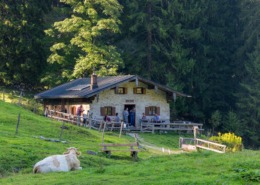Circular tour Grassauer Almen
Circular trail over the Grassau alpine pastures

Circular trail over the Grassau alpine pastures
distance
duration
highest point
meters upwards
meters downwards
Difficulty
easy
The hike begins at the mountain station of the Hochplattenbahn and leads past the Staffn-Alm, which not only offers the usual alpine food, over the somewhat steep climb to the start of the circular trail “Bergwalderlebnisweg Staffen”. On the forest road we go right, following the hiking signs with the destinations Rottauer Moier-Alm and Hefter-Alm. After about 900 m the hiking signs lead us to the right and after another 300 m we reach the turnoff to the left to the Rottauer Moier-Alm, which is 1000 m high. It invites you to have a snack or coffee and cake. If we follow the main path, however, we reach the Hefter-Alm, which is 880 m high, after about 1000 m. Delicious delicacies invite you to have a snack. The destinations Rachl-Alm and Staffn-Alm and also the mountain station as the destination of the hike are mentioned on the hiking signs. Across a meadow, past the Hufnagl-Alm, which is not managed, you reach the Rachl-Alm, which is 920 m high. Here, too, you can enjoy traditional alpine snacks, as well as coffee and cake. From the Rachl-Alm, the hiking signs indicate two different routes. The first route, which is indicated directly at the Alm, is a little shorter, but you have to use a “crossing” at the end, which requires surefootedness. Both routes lead over the relatively steep so-called winter hiking trail to the starting point at the mountain station. Refreshment options: Rottauer Moier-Alm, Hefter Alm, Rachl-Alm, Staffn Alm (please note the opening times)
Einkehrmöglichkeit
Bergstation Hochplattenbahn
 https://www.achental.com/en/storage/sites/10/2025/11/89715__MG_6471.jpg
667
1000
admin
https://www.achental.com/wp-content/uploads/2022/07/achental-logo-weiss-horizontal-RGB@2x.png
admin2025-09-23 10:17:352025-11-09 18:28:29SalzAlpenSteig – Brachtalm – Bergen
https://www.achental.com/en/storage/sites/10/2025/11/89715__MG_6471.jpg
667
1000
admin
https://www.achental.com/wp-content/uploads/2022/07/achental-logo-weiss-horizontal-RGB@2x.png
admin2025-09-23 10:17:352025-11-09 18:28:29SalzAlpenSteig – Brachtalm – Bergen https://www.achental.com/en/storage/sites/10/2025/11/9VruSXPV8ePSxZlnGpViGMZqYnWT2WmVj6N21gVK.webp
768
576
admin
https://www.achental.com/wp-content/uploads/2022/07/achental-logo-weiss-horizontal-RGB@2x.png
admin2025-08-11 01:05:512025-11-09 18:09:55Feldlahnalm tour
https://www.achental.com/en/storage/sites/10/2025/11/9VruSXPV8ePSxZlnGpViGMZqYnWT2WmVj6N21gVK.webp
768
576
admin
https://www.achental.com/wp-content/uploads/2022/07/achental-logo-weiss-horizontal-RGB@2x.png
admin2025-08-11 01:05:512025-11-09 18:09:55Feldlahnalm tour https://www.achental.com/en/storage/sites/10/2025/11/dnnXUqmOoT9qsZJ2w9KjLhaU9rm1fN1Pzba35MkA.jpg
1500
1000
admin
https://www.achental.com/wp-content/uploads/2022/07/achental-logo-weiss-horizontal-RGB@2x.png
admin2025-06-30 01:04:062025-11-09 18:19:21Kneipp circular tour
https://www.achental.com/en/storage/sites/10/2025/11/dnnXUqmOoT9qsZJ2w9KjLhaU9rm1fN1Pzba35MkA.jpg
1500
1000
admin
https://www.achental.com/wp-content/uploads/2022/07/achental-logo-weiss-horizontal-RGB@2x.png
admin2025-06-30 01:04:062025-11-09 18:19:21Kneipp circular tour https://www.achental.com/en/storage/sites/10/2025/11/51253_DSC00673_1920x1278.jpg
1278
1920
admin
https://www.achental.com/wp-content/uploads/2022/07/achental-logo-weiss-horizontal-RGB@2x.png
admin2025-04-30 09:21:342025-11-09 18:26:42Circular tour Grassauer Almen
https://www.achental.com/en/storage/sites/10/2025/11/51253_DSC00673_1920x1278.jpg
1278
1920
admin
https://www.achental.com/wp-content/uploads/2022/07/achental-logo-weiss-horizontal-RGB@2x.png
admin2025-04-30 09:21:342025-11-09 18:26:42Circular tour Grassauer Almen https://www.achental.com/en/storage/sites/10/2025/11/OqqtL2ddEOAljbylKsbGYuTNgwTs5VV03aCmQVk7.jpg
1707
2560
admin
https://www.achental.com/wp-content/uploads/2022/07/achental-logo-weiss-horizontal-RGB@2x.png
admin2025-04-24 01:08:072025-11-09 18:29:46Schmugglerweg to Kössen
https://www.achental.com/en/storage/sites/10/2025/11/OqqtL2ddEOAljbylKsbGYuTNgwTs5VV03aCmQVk7.jpg
1707
2560
admin
https://www.achental.com/wp-content/uploads/2022/07/achental-logo-weiss-horizontal-RGB@2x.png
admin2025-04-24 01:08:072025-11-09 18:29:46Schmugglerweg to Kössen https://www.achental.com/en/storage/sites/10/2025/11/DBEUmwDZxqIa552KGtY7FRaBDy2zuyT3CSJVxLhF.jpg
1705
2560
admin
https://www.achental.com/wp-content/uploads/2022/07/achental-logo-weiss-horizontal-RGB@2x.png
admin2025-04-24 01:08:062025-11-09 18:30:25Schmugglerweg to Klobenstein
https://www.achental.com/en/storage/sites/10/2025/11/DBEUmwDZxqIa552KGtY7FRaBDy2zuyT3CSJVxLhF.jpg
1705
2560
admin
https://www.achental.com/wp-content/uploads/2022/07/achental-logo-weiss-horizontal-RGB@2x.png
admin2025-04-24 01:08:062025-11-09 18:30:25Schmugglerweg to Klobenstein https://www.achental.com/en/storage/sites/10/2025/11/sI0JyHhoSTI8r8TCYiee1ydZojiMieRrirnifIF6.jpg
1707
2560
admin
https://www.achental.com/wp-content/uploads/2022/07/achental-logo-weiss-horizontal-RGB@2x.png
admin2025-04-14 01:03:572025-11-09 18:05:06Auf historischen Pfaden
https://www.achental.com/en/storage/sites/10/2025/11/sI0JyHhoSTI8r8TCYiee1ydZojiMieRrirnifIF6.jpg
1707
2560
admin
https://www.achental.com/wp-content/uploads/2022/07/achental-logo-weiss-horizontal-RGB@2x.png
admin2025-04-14 01:03:572025-11-09 18:05:06Auf historischen Pfaden https://www.achental.com/en/storage/sites/10/2025/11/gzzxtE26tAeHfOmQ2Py2gP7DoMAzPHJDquWDsptw.jpg
1707
2560
admin
https://www.achental.com/wp-content/uploads/2022/07/achental-logo-weiss-horizontal-RGB@2x.png
admin2025-04-09 01:11:092025-11-09 18:43:33Schnappenberg – Schnappenkirche
https://www.achental.com/en/storage/sites/10/2025/11/gzzxtE26tAeHfOmQ2Py2gP7DoMAzPHJDquWDsptw.jpg
1707
2560
admin
https://www.achental.com/wp-content/uploads/2022/07/achental-logo-weiss-horizontal-RGB@2x.png
admin2025-04-09 01:11:092025-11-09 18:43:33Schnappenberg – Schnappenkirche https://www.achental.com/en/storage/sites/10/2025/11/byrz9Rdu4oAN0l849tnGJuWZPJQwfDPf8187HMNO.jpg
1707
2560
admin
https://www.achental.com/wp-content/uploads/2022/07/achental-logo-weiss-horizontal-RGB@2x.png
admin2025-04-09 01:11:092025-11-09 18:33:50Circular hike: Staudacheralm – Schnappenkirche
https://www.achental.com/en/storage/sites/10/2025/11/byrz9Rdu4oAN0l849tnGJuWZPJQwfDPf8187HMNO.jpg
1707
2560
admin
https://www.achental.com/wp-content/uploads/2022/07/achental-logo-weiss-horizontal-RGB@2x.png
admin2025-04-09 01:11:092025-11-09 18:33:50Circular hike: Staudacheralm – Schnappenkirche https://www.achental.com/en/storage/sites/10/2025/11/UkMX7jlNtUgz7DUN7zw7n8VZWRoafD2XjJtGyatW.jpg
1919
2560
admin
https://www.achental.com/wp-content/uploads/2022/07/achental-logo-weiss-horizontal-RGB@2x.png
admin2025-02-24 01:06:162025-11-09 18:14:11Valley circular trail
https://www.achental.com/en/storage/sites/10/2025/11/UkMX7jlNtUgz7DUN7zw7n8VZWRoafD2XjJtGyatW.jpg
1919
2560
admin
https://www.achental.com/wp-content/uploads/2022/07/achental-logo-weiss-horizontal-RGB@2x.png
admin2025-02-24 01:06:162025-11-09 18:14:11Valley circular trail https://www.achental.com/wp-content/uploads/2022/07/achental-logo-weiss-horizontal-RGB@2x.png
0
0
admin
https://www.achental.com/wp-content/uploads/2022/07/achental-logo-weiss-horizontal-RGB@2x.png
admin2025-01-01 01:04:262025-11-09 18:37:56Lake Taubensee via Luftboden- and Kroatensteig
https://www.achental.com/wp-content/uploads/2022/07/achental-logo-weiss-horizontal-RGB@2x.png
0
0
admin
https://www.achental.com/wp-content/uploads/2022/07/achental-logo-weiss-horizontal-RGB@2x.png
admin2025-01-01 01:04:262025-11-09 18:37:56Lake Taubensee via Luftboden- and Kroatensteig https://www.achental.com/wp-content/uploads/2022/07/achental-logo-weiss-horizontal-RGB@2x.png
0
0
admin
https://www.achental.com/wp-content/uploads/2022/07/achental-logo-weiss-horizontal-RGB@2x.png
admin2025-01-01 01:04:232025-11-09 18:25:52Rundweg Schnappenwinkl – Staudach
https://www.achental.com/wp-content/uploads/2022/07/achental-logo-weiss-horizontal-RGB@2x.png
0
0
admin
https://www.achental.com/wp-content/uploads/2022/07/achental-logo-weiss-horizontal-RGB@2x.png
admin2025-01-01 01:04:232025-11-09 18:25:52Rundweg Schnappenwinkl – Staudach https://www.achental.com/wp-content/uploads/2022/07/achental-logo-weiss-horizontal-RGB@2x.png
0
0
admin
https://www.achental.com/wp-content/uploads/2022/07/achental-logo-weiss-horizontal-RGB@2x.png
admin2025-01-01 01:04:222025-11-09 18:10:44River and moor hike through the Achental
https://www.achental.com/wp-content/uploads/2022/07/achental-logo-weiss-horizontal-RGB@2x.png
0
0
admin
https://www.achental.com/wp-content/uploads/2022/07/achental-logo-weiss-horizontal-RGB@2x.png
admin2025-01-01 01:04:222025-11-09 18:10:44River and moor hike through the Achental https://www.achental.com/en/storage/sites/10/2025/11/VVT8YD8z5ZEAzoiXkshUne9HdSbxdwHaAkTvV3bW.jpg
1919
2560
admin
https://www.achental.com/wp-content/uploads/2022/07/achental-logo-weiss-horizontal-RGB@2x.png
admin2025-01-01 01:04:212025-11-09 18:13:31Grießelberg-Rundweg
https://www.achental.com/en/storage/sites/10/2025/11/VVT8YD8z5ZEAzoiXkshUne9HdSbxdwHaAkTvV3bW.jpg
1919
2560
admin
https://www.achental.com/wp-content/uploads/2022/07/achental-logo-weiss-horizontal-RGB@2x.png
admin2025-01-01 01:04:212025-11-09 18:13:31Grießelberg-Rundweg https://www.achental.com/en/storage/sites/10/2025/11/89256_DSC00025.jpg
1536
2048
admin
https://www.achental.com/wp-content/uploads/2022/07/achental-logo-weiss-horizontal-RGB@2x.png
admin2025-01-01 01:04:192025-11-09 18:25:36Circular hike Hinterwössen
https://www.achental.com/en/storage/sites/10/2025/11/89256_DSC00025.jpg
1536
2048
admin
https://www.achental.com/wp-content/uploads/2022/07/achental-logo-weiss-horizontal-RGB@2x.png
admin2025-01-01 01:04:192025-11-09 18:25:36Circular hike Hinterwössen https://www.achental.com/en/storage/sites/10/2025/11/oVwKyuBPBxd4hb8dx2dB9cYkwxVcsjkJrcGgNKx1.jpg
543
768
admin
https://www.achental.com/wp-content/uploads/2022/07/achental-logo-weiss-horizontal-RGB@2x.png
admin2025-01-01 01:04:182025-11-09 18:11:40Geigelstein parking lot to Breitenstein via Karl – to Walchsee
https://www.achental.com/en/storage/sites/10/2025/11/oVwKyuBPBxd4hb8dx2dB9cYkwxVcsjkJrcGgNKx1.jpg
543
768
admin
https://www.achental.com/wp-content/uploads/2022/07/achental-logo-weiss-horizontal-RGB@2x.png
admin2025-01-01 01:04:182025-11-09 18:11:40Geigelstein parking lot to Breitenstein via Karl – to Walchsee https://www.achental.com/en/storage/sites/10/2025/11/wMi70NWgXiYlIFKkdOOpZl1UsbdCQKVH0V6cl5Ni.jpg
1707
2560
admin
https://www.achental.com/wp-content/uploads/2022/07/achental-logo-weiss-horizontal-RGB@2x.png
admin2024-12-30 01:04:102025-11-09 18:06:26Bergwalderlebnisweg Staffen with Hochplattenbahn cable car
https://www.achental.com/en/storage/sites/10/2025/11/wMi70NWgXiYlIFKkdOOpZl1UsbdCQKVH0V6cl5Ni.jpg
1707
2560
admin
https://www.achental.com/wp-content/uploads/2022/07/achental-logo-weiss-horizontal-RGB@2x.png
admin2024-12-30 01:04:102025-11-09 18:06:26Bergwalderlebnisweg Staffen with Hochplattenbahn cable car https://www.achental.com/en/storage/sites/10/2025/11/XQIxdrBep4hkkHo5ZkqtPoAaOrd6Xeszaw9QHE3g.jpeg
1080
1616
admin
https://www.achental.com/wp-content/uploads/2022/07/achental-logo-weiss-horizontal-RGB@2x.png
admin2024-12-30 01:04:092025-11-09 18:13:44Long Moorland Path
https://www.achental.com/en/storage/sites/10/2025/11/XQIxdrBep4hkkHo5ZkqtPoAaOrd6Xeszaw9QHE3g.jpeg
1080
1616
admin
https://www.achental.com/wp-content/uploads/2022/07/achental-logo-weiss-horizontal-RGB@2x.png
admin2024-12-30 01:04:092025-11-09 18:13:44Long Moorland Path https://www.achental.com/en/storage/sites/10/2025/11/KKX9UDoPV12aMw9wvyEJ367aiX6VkZbBz3SUeNbQ.jpg
1707
2560
admin
https://www.achental.com/wp-content/uploads/2022/07/achental-logo-weiss-horizontal-RGB@2x.png
admin2024-12-30 01:04:092025-11-09 18:40:12Via Chiemhauseralm to church Streichenkirche
https://www.achental.com/en/storage/sites/10/2025/11/KKX9UDoPV12aMw9wvyEJ367aiX6VkZbBz3SUeNbQ.jpg
1707
2560
admin
https://www.achental.com/wp-content/uploads/2022/07/achental-logo-weiss-horizontal-RGB@2x.png
admin2024-12-30 01:04:092025-11-09 18:40:12Via Chiemhauseralm to church Streichenkirche https://www.achental.com/en/storage/sites/10/2025/11/65WXYhJdPWmJTz4k5TUHiKCTixL2EgZmb2hAPpa1.jpg
1919
2560
admin
https://www.achental.com/wp-content/uploads/2022/07/achental-logo-weiss-horizontal-RGB@2x.png
admin2024-12-30 01:04:082025-11-09 18:25:16Circular tour via Minaruh and Streunthal
https://www.achental.com/en/storage/sites/10/2025/11/65WXYhJdPWmJTz4k5TUHiKCTixL2EgZmb2hAPpa1.jpg
1919
2560
admin
https://www.achental.com/wp-content/uploads/2022/07/achental-logo-weiss-horizontal-RGB@2x.png
admin2024-12-30 01:04:082025-11-09 18:25:16Circular tour via Minaruh and Streunthal
 Circular tour Vorderalm – Brachtalm – Staudacher Alm
Circular tour Vorderalm – Brachtalm – Staudacher Alm Achental - Chiemsee-Chiemgau holiday region
We firmly believe that the internet should be available and accessible to anyone, and are committed to providing a website that is accessible to the widest possible audience, regardless of circumstance and ability.
To fulfill this, we aim to adhere as strictly as possible to the World Wide Web Consortium’s (W3C) Web Content Accessibility Guidelines 2.1 (WCAG 2.1) at the AA level. These guidelines explain how to make web content accessible to people with a wide array of disabilities. Complying with those guidelines helps us ensure that the website is accessible to all people: blind people, people with motor impairments, visual impairment, cognitive disabilities, and more.
This website utilizes various technologies that are meant to make it as accessible as possible at all times. We utilize an accessibility interface that allows persons with specific disabilities to adjust the website’s UI (user interface) and design it to their personal needs.
Additionally, the website utilizes an AI-based application that runs in the background and optimizes its accessibility level constantly. This application remediates the website’s HTML, adapts Its functionality and behavior for screen-readers used by the blind users, and for keyboard functions used by individuals with motor impairments.
If you’ve found a malfunction or have ideas for improvement, we’ll be happy to hear from you. You can reach out to the website’s operators by using the following email
Our website implements the ARIA attributes (Accessible Rich Internet Applications) technique, alongside various different behavioral changes, to ensure blind users visiting with screen-readers are able to read, comprehend, and enjoy the website’s functions. As soon as a user with a screen-reader enters your site, they immediately receive a prompt to enter the Screen-Reader Profile so they can browse and operate your site effectively. Here’s how our website covers some of the most important screen-reader requirements, alongside console screenshots of code examples:
Screen-reader optimization: we run a background process that learns the website’s components from top to bottom, to ensure ongoing compliance even when updating the website. In this process, we provide screen-readers with meaningful data using the ARIA set of attributes. For example, we provide accurate form labels; descriptions for actionable icons (social media icons, search icons, cart icons, etc.); validation guidance for form inputs; element roles such as buttons, menus, modal dialogues (popups), and others. Additionally, the background process scans all the website’s images and provides an accurate and meaningful image-object-recognition-based description as an ALT (alternate text) tag for images that are not described. It will also extract texts that are embedded within the image, using an OCR (optical character recognition) technology. To turn on screen-reader adjustments at any time, users need only to press the Alt+1 keyboard combination. Screen-reader users also get automatic announcements to turn the Screen-reader mode on as soon as they enter the website.
These adjustments are compatible with all popular screen readers, including JAWS and NVDA.
Keyboard navigation optimization: The background process also adjusts the website’s HTML, and adds various behaviors using JavaScript code to make the website operable by the keyboard. This includes the ability to navigate the website using the Tab and Shift+Tab keys, operate dropdowns with the arrow keys, close them with Esc, trigger buttons and links using the Enter key, navigate between radio and checkbox elements using the arrow keys, and fill them in with the Spacebar or Enter key.Additionally, keyboard users will find quick-navigation and content-skip menus, available at any time by clicking Alt+1, or as the first elements of the site while navigating with the keyboard. The background process also handles triggered popups by moving the keyboard focus towards them as soon as they appear, and not allow the focus drift outside it.
Users can also use shortcuts such as “M” (menus), “H” (headings), “F” (forms), “B” (buttons), and “G” (graphics) to jump to specific elements.
We aim to support the widest array of browsers and assistive technologies as possible, so our users can choose the best fitting tools for them, with as few limitations as possible. Therefore, we have worked very hard to be able to support all major systems that comprise over 95% of the user market share including Google Chrome, Mozilla Firefox, Apple Safari, Opera and Microsoft Edge, JAWS and NVDA (screen readers).
Despite our very best efforts to allow anybody to adjust the website to their needs. There may still be pages or sections that are not fully accessible, are in the process of becoming accessible, or are lacking an adequate technological solution to make them accessible. Still, we are continually improving our accessibility, adding, updating and improving its options and features, and developing and adopting new technologies. All this is meant to reach the optimal level of accessibility, following technological advancements. For any assistance, please reach out to
